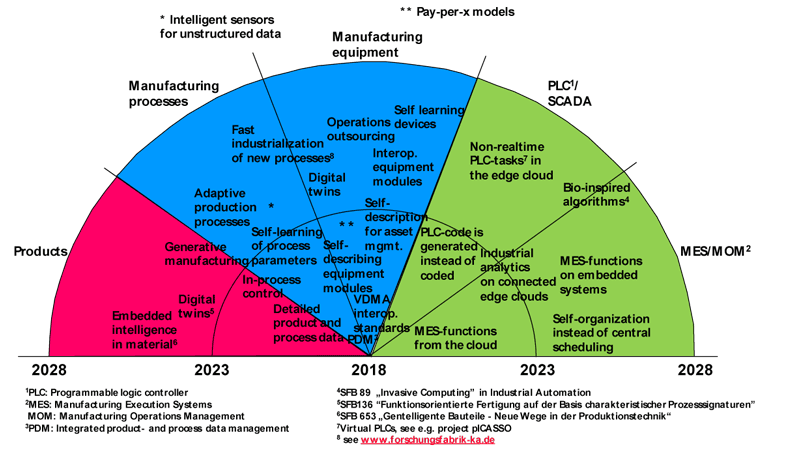by Olaf Sauer (Fraunhofer IOSB)
Together with colleagues from the Fraunhofer Industrie 4.0-community Fraunhofer IOSB is working on a definition of digital twins and on use cases that show their benefits. A Fraunhofer whitepaper is under work, where we take into account various aspects of digital twins such as material science, product development, manufacturing process development, digital factories, manufacturing operations and reference architectures. In this paper we describe some general aspects of digital twins and illustrate the concept with some examples from companies that have been early to adopt the concepts of digital twins.
Currently the digital twin (see Figure 1) is one of the emerging technologies in discussion in several domains; it is a concept of modelling assets with all geometrical data, kinematic functionality and logical behaviour using digital tools. The digital twin refers directly to the physical asset and allows it to be simulated, controlled and improved. According to Gartner today less than 1 % of physical machines and components “are modelled such that the models capture and mimic behaviour” [1].
Currently digital twins are discussed in Industry 4.0-working groups when talking about the asset administration shell [1] or industry 4.0-components. From our point of view, the digital twin will become a major topic for research in the coming years, because digital twins are not single objects or monolithic data models, but are composed of different aspects of digital representations, functionalities, models, interfaces etc. From a manufacturing and its engineering perspective, it is evident that digital twins perform different tasks, such as:
- Self-description using unique attributes and parameters describing configuration data, e.g. for auto-identification, to connect machines and components easily to MES and other Industrial IoT-solutions [2].
- Description of skills, including parts of control code leading to the result, that an assembly of components and their respective parts of control logic fit to a finally running control program. This leads to a PLUGandWORK, allowing for plugging in new components at runtime, and integrating them automatically on a functional level [3].
- Models of the correct runtime behaviour of a machine, a line or an entire manufacturing shop, based on learned data from machine learning.
- Offline- and online-simulation including the very different types of simulation such as finite element simulation, virtual commissioning or physics simulation in which produced goods interact with machine kinematics. Ideally, different simulation models must be able to interact to come to an integrated simulation model. Up to now, one of the main uses of the digital twin has been for simulation; as we point out here, this definition is much to narrow.
- Digital factory describing machines and other manufacturing resources, buildings and utilities. Building information model (BIM) might also be part of a digital twin as long as it contains relevant information, e.g. topology. The concept of digital factories already has a long history and is described by well-known standards, such as VDI 4499.
- Services that a cyber-physical component offers to its users.
- IT security, access rights, handling of certificates, version management and compatibility checks of different versions of digital twins [4].

Figure 1: Fraunhofer-internal research results for manufacturing related technologies.
For Industry 4.0 and the digitisation of manufacturing digital twins are essential. Their content must be used through different stages of the lifecycle, within different types of platforms and various tools, from engineering to after sales services. The following use cases already show the potential benefits, e.g., to optimise products and processes almost during runtime:
- Automation supplier WAGO has developed an approach called DIMA (decentralised intelligence for modular equipment), enabling modules from different vendors to be integrated into a final production system. Its core is the Module Type Package (MTP), a kind of self-description of the modules. The MTP can be accessed through an interface and contains communication parameters, functional production services that the module offers to the entire production system and information for the production monitoring system.
- Components from FESTO are described as AutomationML-models including geometry, kinematics and software. They also refer e.g. to EPLAN schematic services, which are FESTO-built Macro-libraries for EPLAN Electric P8, V2. The components also store data from the application and from operations, pre-process the data according to VDMA 24582 in CODESYS V3 and transfer these information further on to a cloud.
- Each HOMAG-machine for manufacturing wooden work pieces has its own asset administration shell including a proprietary XML-description and an OPC UA-communication. Homag offers machine related services, e.g. the diagnosis system woodScout including an integrated machine documentation, via a cloud connector from the Homag owned Tapio-Cloud, based on Microsoft Azure. Homag’s customer Nobilia, a producer of kitchen furniture, uses the Homag digital twins to demonstrate a virtual customer specific production of lot size 1.
From these first examples it is crystal clear that the application of digital twins will be very specific and always according to the use case; however, it must be possible to integrate the different part models of the digital twins easily based on their unique description.
References:
[1] R. Drath: “Die Rolle der Industrie 4.0 ‘Verwaltungsschale’ und des ‘Digitalen Zwillings’ im Lebenszyklus einer Anlage. VDI-Bericht 2293, Automation 2017, Düsseldorf, VDI-Verlag 2017, S. 600-615.
[2] O. Sauer: “Lösungsbausteine für herstellerunabhängige, standardisierte Schnittstellen in der Produktion, in: Th. Schulz. (Hrsg.): Industrie 4.0: Potenziale erkennen und umsetzen. Vogel Business Media, 2017, S. 87-106.
[3] Pfrommer, J. et al.: “Fähigkeiten adaptiver Produktionsanlagen. atp edition 55, Nr. 11, 2013, S. 42-49.
[4] Schleipen et al.: “SecurePLUG and WORK, Abschlussbericht”, Karlsruhe: Fraunhofer IOSB, 2017. https://kwz.me/hdm
Please contact:
Olaf Sauer
Fraunhofer IOSB, Germany
+49 721 6091 477,











